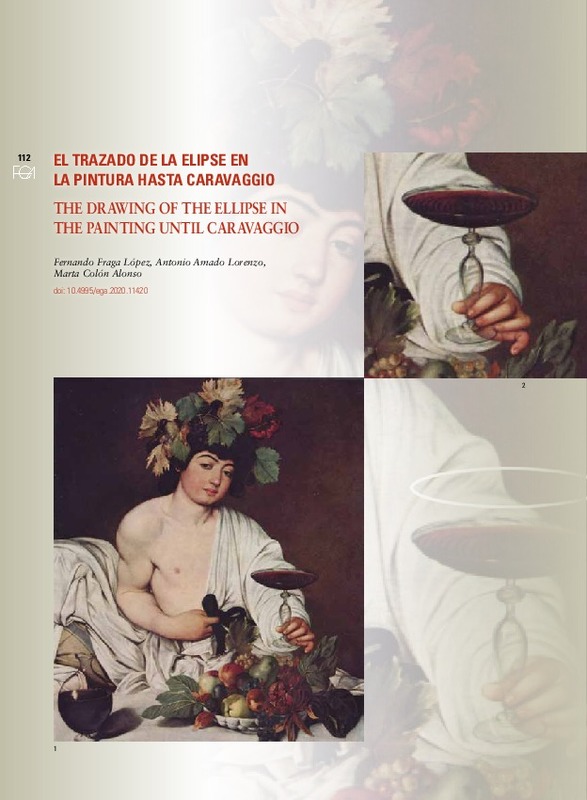JavaScript is disabled for your browser. Some features of this site may not work without it.
Buscar en RiuNet
Listar
Mi cuenta
Estadísticas
Ayuda RiuNet
Admin. UPV
The drawing of the ellipse in the painting until Caravaggio
Mostrar el registro sencillo del ítem
Ficheros en el ítem
| dc.contributor.author | Fraga, Fernando
|
es_ES |
| dc.contributor.author | Amado Lorenzo, Antonio
|
es_ES |
| dc.contributor.author | Colón Alonso, Marta
|
es_ES |
| dc.date.accessioned | 2020-03-23T08:57:25Z | |
| dc.date.available | 2020-03-23T08:57:25Z | |
| dc.date.issued | 2020-03-13 | |
| dc.identifier.issn | 1133-6137 | |
| dc.identifier.uri | http://hdl.handle.net/10251/139166 | |
| dc.description.abstract | [EN] The circle is present in a great number of elements in our environment. As it has to be seen in perspective, is perceived by the eye as a perfect ellipse, one can assure that the latter is the most frequent in architecture, art and engineering. Besides, apart from other geometry simple forms, its drawing even using tools as compasses or templates, conveys an important complexity. To revise the innumerable quantity of ellipses that have been drawn and painted since ancient times, confirms that making the as it should be, free handed, is practically impossible.The article studies the drawing of the ellipse in the western art until the xvii century. It starts from the Giotto’s experiences and studies on Durero’s chronicles to eventually analyse as a representative selection of painters (Campin, Leonardo or Raphael) who faced the issue without managing to resolve it, unlike Caravaggio who, in a way, was the only one to achieve it (Figs 1 and 2). | es_ES |
| dc.description.abstract | [ES] El círculo está presente en infinidad de elementos de nuestro entorno. Debido a que, visto en perspectiva, es percibido por el ojo como una elipse perfecta, no es descabellado afirmar que esta última es la curva más frecuente en la arquitectura, el arte o la ingeniería. Además, a diferencia de otras formas geométricas simples, su trazado, aún con la ayuda de herramientas como compases o plantillas, conlleva una complejidad importante. Repasar la innumerable cantidad de elipses dibujadas y pintadas desde la antigüedad, confirma que hacerlo con exactitud, a mano alzada, es prácticamente imposible. El artículo estudia la problemática del trazado de la elipse en el arte occidental hasta el siglo xvii. Se parte de la experiencia de Giotto y de los estudios acerca de las cónicas de Durero, para analizar posteriormente cómo una selección representativa de pintores (Campin, Leonardo o Rafael) se enfrentaron a la cuestión sin conseguir resolverla, a diferencia de Caravaggio quien, de alguna man | es_ES |
| dc.language | Español | es_ES |
| dc.language | Inglés | es_ES |
| dc.publisher | Universitat Politècnica de València | es_ES |
| dc.relation.ispartof | EGA Expresión Gráfica Arquitectónica | es_ES |
| dc.rights | Reconocimiento - No comercial - Sin obra derivada (by-nc-nd) | es_ES |
| dc.subject | Pintura | es_ES |
| dc.subject | Perspectiva | es_ES |
| dc.subject | Elipse | es_ES |
| dc.subject | Geometría | es_ES |
| dc.subject | Caravaggio | es_ES |
| dc.subject | Painting | es_ES |
| dc.subject | Perspective | es_ES |
| dc.subject | Ellipse | es_ES |
| dc.subject | Geometry | es_ES |
| dc.title | The drawing of the ellipse in the painting until Caravaggio | es_ES |
| dc.title.alternative | El trazado de la elipse en la pintura hasta Caravaggio | es_ES |
| dc.type | Artículo | es_ES |
| dc.identifier.doi | 10.4995/ega.2020.11420 | |
| dc.rights.accessRights | Abierto | es_ES |
| dc.description.bibliographicCitation | Fraga, F.; Amado Lorenzo, A.; Colón Alonso, M. (2020). The drawing of the ellipse in the painting until Caravaggio. EGA Expresión Gráfica Arquitectónica. 25(38):112-125. https://doi.org/10.4995/ega.2020.11420 | es_ES |
| dc.description.accrualMethod | OJS | es_ES |
| dc.relation.publisherversion | https://doi.org/10.4995/ega.2020.11420 | es_ES |
| dc.description.upvformatpinicio | 112 | es_ES |
| dc.description.upvformatpfin | 125 | es_ES |
| dc.type.version | info:eu-repo/semantics/publishedVersion | es_ES |
| dc.description.volume | 25 | es_ES |
| dc.description.issue | 38 | es_ES |
| dc.identifier.eissn | 2254-6103 | |
| dc.relation.pasarela | OJS\11420 | es_ES |
| dc.description.references | BACCARI, Ada, 2010, A Brief Outline. Accademia Nazionale dei Lincei, Roma. | es_ES |
| dc.description.references | CHING, Francis D.K. 1999. Dibujo y proyecto. Barcelona: Gustavo Gili. | es_ES |
| dc.description.references | DE SIMONI, Luigi; DE SIMONI, Pietro, 1992. Spazio Prospettico. Roma: Bonacci. | es_ES |
| dc.description.references | DURERO, Alberto, 2000 [1525]. De la medida. Madrid: Akal. | es_ES |
| dc.description.references | GENTIL, Jose Mª, 2011. Sobre la supuesta perspectiva antigua. Sevilla: Secretariado de Publicaciones de la Universidad de Sevilla. | es_ES |
| dc.description.references | GOMBRICH, Ernst H., 1995 [1950]. La historia del arte. Madrid: Debate. | es_ES |
| dc.description.references | KIRCHER, Athanasius, 1650. Athanasii Kircheri Fvldensis e Soc. Iesv presbyteri Mvsvrgia vniversalis: Ars magna. Roma: Jacobus Viva. | es_ES |
| dc.description.references | LANGDON, Helen, 2010, Caravaggio, Edhasa, Barcelona | es_ES |
| dc.description.references | PANOFSKI, Erwin, 2005 [1943]. Vida y arte de Alberto Durero. Madrid: Alianza Forma. | es_ES |
| dc.description.references | RUSKIN, John, 1999 [1857]. Técnicas de dibujo. Barcelona: Laertes. | es_ES |
| dc.description.references | VASARI, Giorgio, 1906 [1550]. Le opere de Giorgio Vasari. Florencia: Sansoni. | es_ES |
| dc.description.references | VILLANUEVA, Lluis, 1996. Perspectiva lineal. Su relación con la fotografía. Barcelona: UPC. | es_ES |
| dc.description.references | WRIGHT, Lawrence, 1985. Tratado de perspectiva. Barcelona: Stylos. | es_ES |








